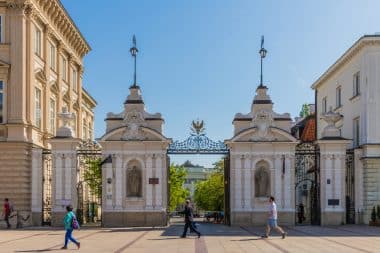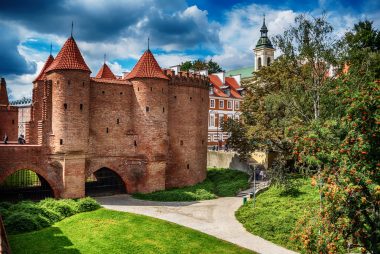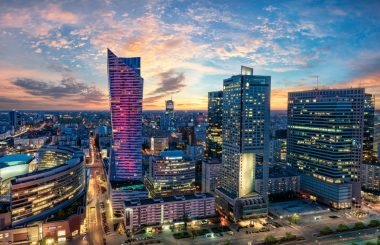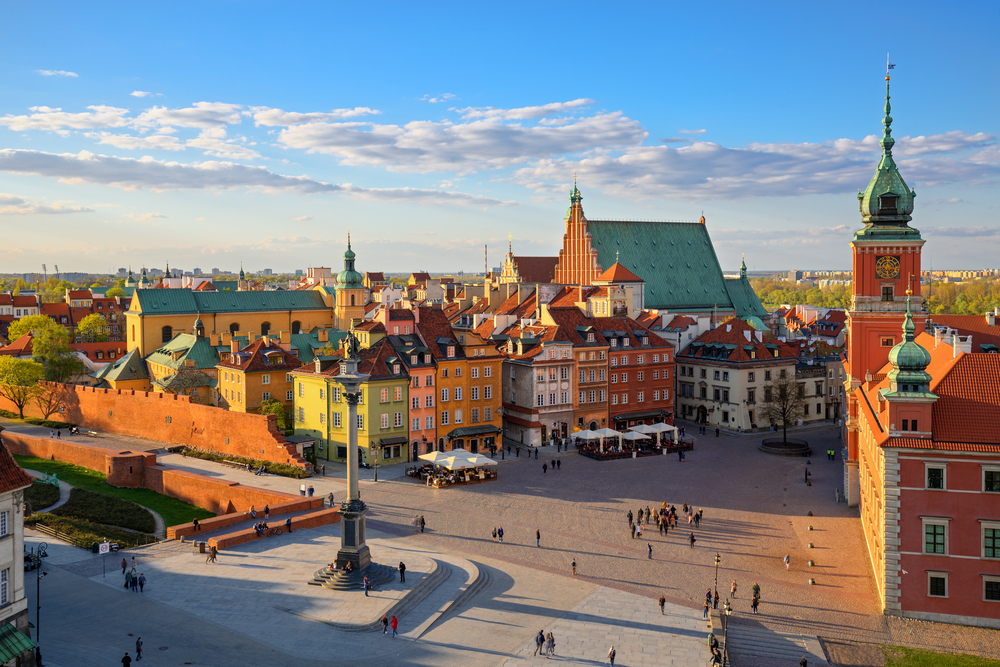Warsaw – Polish capital and modern metropolis with over 1.7 million inhabitants – has long since ceased to be an insider tip for tourists. This is where a UNESCO-listed old town, historic monuments, green parks and modern Poland meet. Whether it’s the relaxed sightseeing of a cultural tour or a tour through the lively nightlife – Warsaw presents itself as an ideal destination for a city trip.
UNESCO World Heritage Site – The attractions in Warsaw’s Old Town

Since 1980, Warsaw’s historic core has been a UNESCO World Heritage Site. After the great destruction caused by the Second World War, the historic city centre was reconstructed true to the original in the late 40s and 50s. And even today, the historic panorama between the castle and St. John’s Cathedral forms an attractive destination for tourists in the heart of Warsaw. If you visit Warsaw, you should take your time for the old town.
Here stands the Warsaw Royal Castle with architectural Renaissance influences, where from the late Middle Ages to the In the 18th century, the Polish kings resided. The history of the neo-Gothic St. John’s Cathedral dates back to the 14th century, it is considered the oldest church in Warsaw. Classic sightseeing in Warsaw’s Old Town also includes the Barbican from the 16th and the 22-metre-high Sigismund Column from the 17th century.
If you want to stop off at restaurants or cafés, you should not miss the historic market square, whose photogenic panorama now enjoys an international reputation.
Historic architecture on the Royal Route

But Warsaw is not only the old town – even far away from the restored core, you can discover architecture and historic sacred buildings worth seeing. A popular place to stroll is the Royal Route, which leads from the Old Town to the Rondo Charles’a de Gaulle’a, for example, and thus knows how to present some of Warsaw’s sights along the way.
The Polish monarchs once rode along the great representative street, especially in the Krakow suburbs district you can discover historic castles such as today’s Presidential Palace, the baroque Potocki Palace from the 17th century and the classicist Tyszkiwicz Palace from the 18th century. Along the Royal Route are some of Warsaw’s most important sacred buildings – including the Gothic St. Anne’s Church and the Baroque St. Joseph’s Church.
If you can’t get enough of historic Warsaw far away from the Royal Route, you should check out architectural marvels such as the Warsaw Citadel from the 19th century, the gigantic National Theatre Teatr Wielki from the 19th century and the landmark Kulturpalast from the 20th century. One of Warsaw’s most important historical districts is the popular Praga, which boasts historic buildings, proximity to Warsaw’s idyllic Vistula riverbank, parks and bars.
Natural Warsaw between the Vistula River and Łazienki Park

The natural dimension of Warsaw is revealed in the city’s parks and green spaces. A prominent example is Łazienki Park, which provides natural greenery in the central district of Śródmieście. The history of the idyllic 80-hectare park dates back to the 17th century. Here, too, there is the Łazienki Palace, an impressive historical building in the classicist style, which goes back to the architect Tylman van Gameren.
Between Kobushi magnolia, weeping willow and lilac, you can discover the Chopin monument, the antique-inspired theatre on the island and the classicist Belvedere Palace from the 17th century. Agrykola Park in the south of the city is also recommended, where you can see the historic Ujazdów Castle. One of the central parks is also the Pole Mokotowskie, which is built around a lake in the middle of the park. An idyllic walk along partly green banks is offered on the Vistula in the heart of Warsaw.
Warsaw’s museums and cultural institutions
Visitors interested in culture can enjoy museums in Warsaw, some of which are internationally renowned. The dark chapter of the Second World War, for example, is commemorated by the Museum of the Warsaw Uprising, which has been located in the former tram power plant since 2004. The history of the Jewish inhabitants of Warsaw and Poland from the Middle Ages to the present day is dedicated to the history of Polish Jews. Also worth mentioning is the National Museum Warsaw, which houses about 800,000 exhibits of works of art, paintings and sculptures.
Culinary specialties, shopping streets and nightlife
As befits the capital of Poland , Warsaw has a number of restaurants serving the country’s specialties – serving culinary specialties such as bigos or Poland’s popular pierogi and meat dishes. The milk bars, which became popular during the socialist era, are still very popular today as cheap snacks. Far from that, Warsaw has the culinary diversity of a cosmopolitan city – from Italian to Asian to Eastern European cuisine.
Restaurants can be found mainly in the historic center – whether on the market square or not far from the Königsweg. Modern Warsaw is evident in the capital’s nightlife, for example in the popular Opera Club in the basement of the National Theatre, Room 13 or the Tygmont jazz club. If you like shopping and strolling, you should not miss the noble shopping street Nowy Swiat, one of the largest shopping centers is the Arkadia Shopping Mall.
Excursion destinations around Warsaw: the Kampinos National Park
On the northwestern outskirts of Warsaw lies the Kampinos National Park, which was established in 1959. Here you can discover natural Poland between swamps, river arms, pastures and primeval forests. Since 2000, the park has been part of the UNESCO Biosphere Reserve, where rare animal species such as the moose, the beaver and the lynx feel at home.
Museums
Warsaw, the capital of Poland, is rich in history and culture. Here are some of the must-see museums to visit during your stay:
- Warsaw Uprising Museum: This museum is dedicated to the Warsaw Uprising of 1944 and features interactive exhibitions, films, and artifacts. Address: Grzybowska 79, 00-844 Warsaw.
- POLIN Museum of the History of Polish Jews: A modern museum that tells the thousand-year history of the Jews in Poland. Address: Anielewicza 6, 00-157 Warsaw.
- Royal Castle: The reconstructed castle of Polish kings with magnificent interiors and works of art. Address: Plac Zamkowy 4, 00-277 Warsaw.
- National Museum Warsaw: An extensive collection of Polish and international artworks, including paintings, sculptures, and decorative arts. Address: Aleje Jerozolimskie 3, 00-495 Warsaw.
- Chopin Museum: A museum dedicated to the life and work of the famous composer Fryderyk Chopin. Address: Okólnik 1, 00-368 Warsaw.
- Copernicus Science Center: An interactive science museum for all ages that vividly explains scientific phenomena. Address: Wybrzeże Kościuszkowskie 20, 00-390 Warsaw.
Restaurants
Warsaw offers a variety of restaurants serving local and international cuisine. Here are some of the best restaurants in town:
- Atelier Amaro: The first Polish restaurant to be awarded a Michelin star, known for its innovative Polish cuisine. Address: Agrykola 1, 00-460 Warsaw.
- Restauracja Polska Różana: An elegant restaurant serving traditional Polish dishes in a beautiful garden setting. Address: Chocimska 7, 00-791 Warsaw.
- U Fukiera: A historic restaurant in the Old Town Market Square that offers Polish cuisine in a charming setting. Address: Rynek Starego Miasta 27, 00-272 Warsaw.
- Senses Restaurant: Another Michelin-starred restaurant known for its creative European cuisine. Address: Bielańska 12, 00-085 Warsaw.
- Stary Dom: A traditional Polish restaurant, known for its excellent meat dishes and homely atmosphere. Address: Puławska 104/106, 02-620 Warsaw.
Well-known hotels
Warsaw offers a variety of accommodation options, from luxurious hotels to cozy boutique hotels:
- Raffles Europejski Warsaw: A luxurious hotel with a rich history, offering elegantly furnished rooms and first-class service. Address: Krakowskie Przedmieście 13, 00-071 Warsaw.
- Hotel Bristol, a Luxury Collection Hotel: A historic five-star hotel in the heart of the city, known for its classic style and first-class service. Address: Krakowskie Przedmieście 42/44, 00-325 Warsaw.
- InterContinental Warsaw: A modern high-rise hotel with excellent views of the city and first-class amenities. Address: Emilii Plater 49, 00-125 Warsaw.
- H15 Boutique Hotel: A stylish boutique hotel in a historic building that offers luxurious rooms and suites. Address: Poznańska 15, 00-680 Warsaw.
- The Westin Warsaw: A modern hotel in the city’s business district with comfortable rooms and excellent service. Address: Aleja Jana Pawła II 21, 00-854 Warsaw.
How to get there
Warsaw is well connected to the transport network and easily accessible:
- Plane:
- Warsaw Chopin Airport (WAW): The largest airport in Poland, about 10 km southwest of the city center. Regular bus and train services take travelers to the city center.
- Warsaw-Modlin Airport (WMI): About 40 km northwest of Warsaw, mainly for low-cost airlines.
- Train:
- Warsaw Central Station (Warszawa Centralna): A central hub in the Polish rail network with connections to many national and international destinations.
- Car: Good road connections via the A2 (Berlin-Warsaw) and S8 (Białystok-Wrocław) motorways.
- Bus: Long-distance buses from FlixBus and Eurolines connect Warsaw with many European cities.


